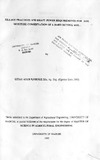| dc.description.abstract | Field experiments were conducted to study the draft power requirement of four tillage
operations and their effect on moisture conservation in a Luvisol soil. The experimental sites
were located in Iiuni in Machakos District (Kenya), a region with semi-arid type of climate.
The experiments were conducted during the short rain season of 1993 and the long rain
season of 1994 in Randomized Complete Block experimental design with three and four
replications respectively. The treatments were; deep mouldboard tillage (DTM) to 17 em,
shallow mouldboard tillage (STM) to 11 em, deep cultivator tillage (DTC) to 10 em, shallow
cultivator tillage (STC) to 7 em and no-till (NT). A pair of oxen provided the draft power.
Soil moisture, bulk density, penetration resistance and crop height were monitored
throughout the crop growing period of a Maize (Zea Mays) crop. The Maize crop was
harvested at the end of the crop growing period so that grain and dry matter yield
comparisons could be made.
It was found that, the draft power requirement was significantly different (p = 0.05)
between the shallow and deep tillage treatments in both experimental seasons. During the
short rain season, DTM had the highest draft power requirements of 1.00 kW followed by
DTC (0.85 kW), STC (0.78 kW) and STM (0.67 kW). In the long rain season, draft power
requirements were highest for DTC (0.96 kW) followed by DTM (0.91 kW), and STC and
STM (0.77 kW ) each. Higher draft power requirement for DTM was as a result of the
corresponding higher depth of tillage (17 ern). High draft power requirement for DTC was
due to the higher depth (10 ern) of tillage and probably higher weight of equipment (39 kg)
as compared to 32 kg for the mouldboard plough.
Available soil moisture was not significantly different between all treatments from the
vegetative to pollination stages of the crop. Changes in bulk density and penetration
resistance (before and after tillage) were significantly different (p = 0.001 and p = 0.05)
between the mouldboard and cultivator tillage treatments, for the short and long rain seasons
respectively. The high surface roughness for the DTM treatment probably increased surface
depressional water storage and thus increased the time available for infiltration, therefore
more water was stored in the profile. Low available soil moisture for the NT treatment was
due to the low surface roughness which led to the development of a dense crust over the
entire soil surface resulting in surface runoff water losses.
Crop yields were not significantly different (P = 0.05) between all treatments during
both seasons. During the short rain season DTM had the highest grain yield (1632 kg/ha)
followed by STC (1398 kg/ha), STM (1328 kg/ha), DTC (1319 kg/ha) and NT (1126 kg/ha).
DTM had the highest dry matter yield (4974 kg/ha) followed by STM (4435 kg/ha), DTC
(4291 kg/ha), STC (4278 kg/ha) and NT (3508 kg/ha). During the long rain season, STC
had the highest grain yield of 1320 kg/ha followed by DTM (1234 kg/ha), NT (1119 kg/ha),
DTC (1106 kg/ha) and STM (947 kg/ha). Dry matter yield was highest for DTM (3925
kg/ha) followed by STC (3474 kg/ha), NT (2850 kg/ha), DTC (2613 kg/ha) and STM (2499
kg/ha).
Overall, deep tillage with the mouldboard should be recommended for the short rain
season as the results indicate a higher crop yield. This may also imply that surface
roughness is the single most important condition determining moisture availability for crop
growth under the conditions of the experiments. The corresponding draft requirements for
DTM could probably be lowered if tillage was performed immediately after the long rain
season when the soil moisture conditions are favourable. Shallow tillage with the cultivator
could also be used in the long rain season without any adverse effects on soil properties and
crop yields. | en |

